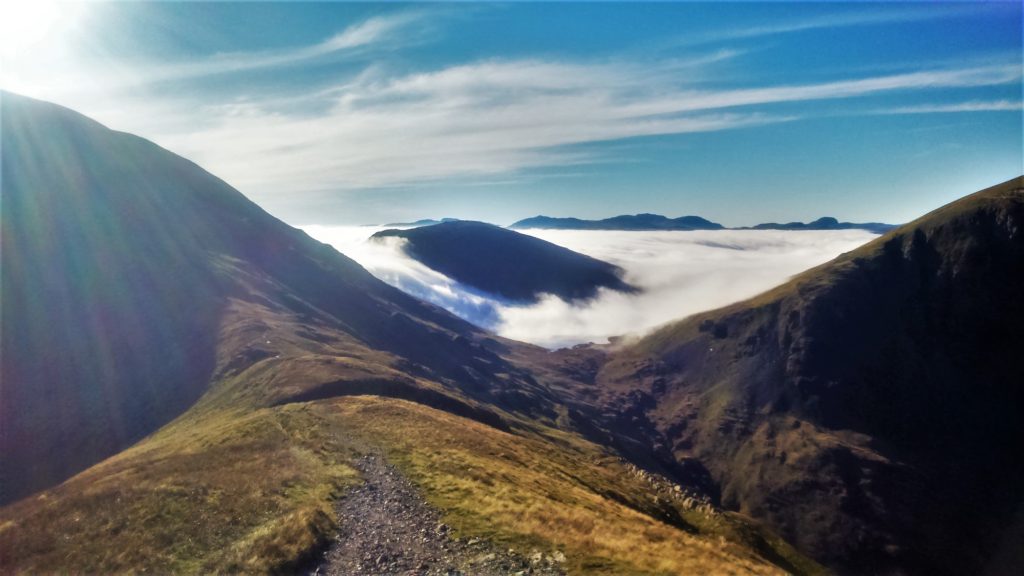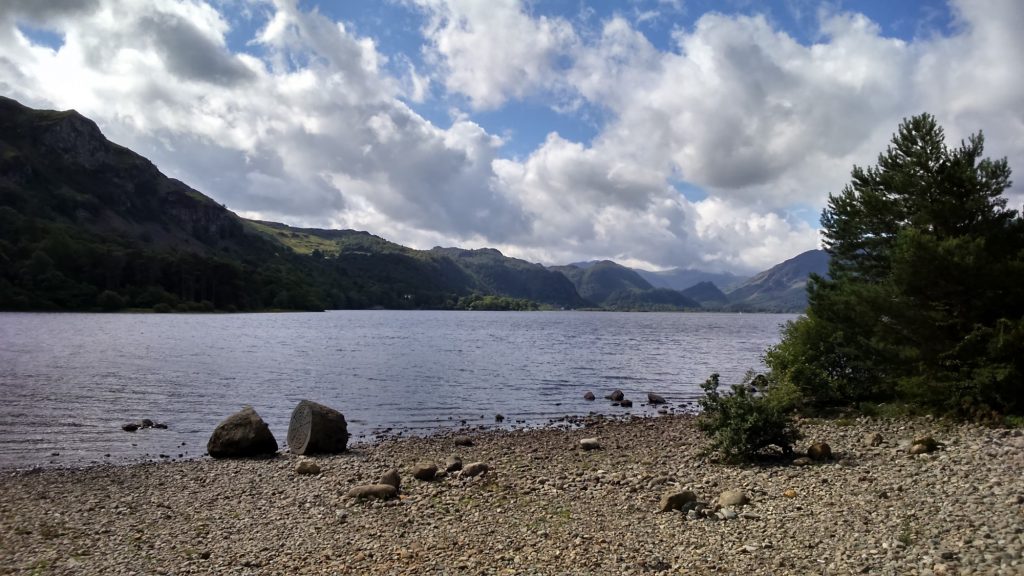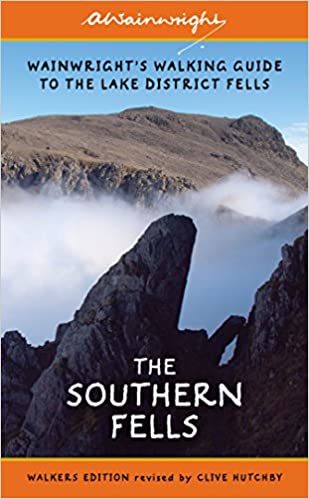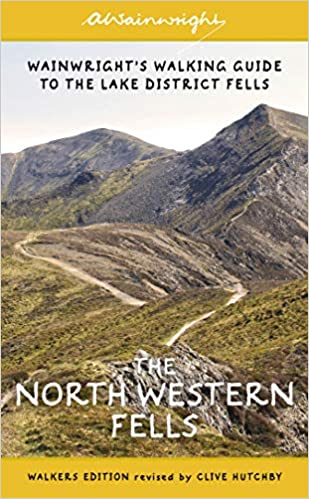For me, the Wainwright Pictorial Guides are essential for any walker who loves the Lake District. They are packed full of information, routes, illustrations and anecdotes. Even if you don’t use them for walking, they are works of art in themselves.
Let’s look at the previous editions and then compare to the new ones.

Wainwright Pictorial Guides: First Edition
The original books are collectors items now and are not so easy to come by. There are later reprints, of which I have some myself. These all have the classic hardback and simple white background dust cover. They are beautiful things and lovely to handle. However, they were first published over fifty years ago and many things have changed. There are many more visitors to the Lake District now, than there were back then. Many of the paths in the original books have been diverted, to reduce erosion. So, often the paths described in the books have changed. They were in need of an update. Having said that, Wainwright made his own paths and was in favour of the walker doing the same.

Wainwright Pictorial Guides: Second Edition
Between 2005 and 2010, Chris Jesty revised the original books, with a view to updating the routes to the newer diverted routes. These books were marked as the Second Edition. They have a dust cover with a photograph on, rather than the original illustrated one. These books are very sympathetic updates and complement the originals well. I have several of this edition and they are excellent. However, even these are now at least ten years old now. Things change so fast now, with access improving, that another update was required.

Wainwright Pictorial Guides: Third Edition
A new third edition has recently been introduced. They were compiled between 2015 and 2020. These are now considered to be the edition to be used by walkers. These books take nothing away from the originals or even the Second Edition. On the contrary, Clive Hutchby has added to them with important information about path rerouting and access. Back in 2015, Clive described why he felt that the books needed to be updated in an article in the Ramblers magazine.

These new books are flexibound, rather than the traditional hardcover. Whilst I really like the old hardcover, I think that the flexibinding still gives a quality feel but more modern and better for storing in a pocket.
I’ve listed the latest books below. If you click on them, they will link you to Amazon, where you can purchase the book. For those who prefer an electronic book, most are available as Kindle books too.
Just a note for potential buyers, the Walker’s Edition (Third Edition), of the Wainwright Pictorial Guides, come in paperback and flexibinding. The paperback is what you’d expect of a typical paperback guidebook. The flexibound version is a more premium product and is likely to last longer in a rucksack. So, if you see paperback and flexibound options, they are different. Be careful when selecting flexibound, as some online retailers are describing paperback versions as flexibound. Check before purchasing.
Declaration: We are a participant in the Amazon Services LLC Associates Program, an affiliate advertising program designed to provide a means for us to earn fees by linking to Amazon.com and affiliated sites.
List of Walker’s Edition Books
- One: The Eastern Fells
- Two: The Far Eastern Fells
- Three: The Central Fells
- Four: The Southern Fells
- Five: The Northern Fells
- Six: The North Western Fells
- Seven: The Western Fells
Book One: The Eastern Fells
This book is probably the one that I’ve used the most over the years. This is simply because it covers the fells to the west of Ullswater, my favourite lake. One of these fells is significant to many walkers, Helvellyn, my favourite fell.
I’ve probably climbed more fells in this book than in any other. This book brings to mind a great holiday one November, in Patterdale. It saw my girlfriend, Julie, and I walk four Wainwrights one day and six the next. These were two simple routes and two of the best walks and best days in my life.
The first was a circular route around Helvellyn. We walked up Grisedale from Patterdale and lunched at Grisedale Tarn. Then we climbed over Dollywaggon and Nethermost Pikes, to reach the summit and the shelter cairn, where we rested in the sun. We descended via Swirral Edge and then decided to add on Catstye Cam, as the sun went down. We arrived back at the Travellers Rest in the dark.
The other was around Fairfield. We weren’t going to walk on this day but the weather was amazing. We set off early from Patterdale and summited Arnison Crag, quickly followed by Birks. On to St Sunday Crag, which is an amazing place in itself, before the summit. On Fairfield, we were rewarded with an inversion. The high peaks all round emerging from low cloud and cloudfalls forming as it fell into the dales. We completed the return leg over Hart Crag and Hartsop above How, and returned to Patterdale in the dark again.
There’s good reason why Wainwright chose this region for his first book. This would be a great first Wainwright book for anyone.
Book Two: The Far Eastern Fells
This book covers the fells further east from Book 1. I haven’t done many fells from this book but one of my other favourites is Place Fell, on the east side of Ullswater.
I have climbed Place Fell multiple times. The reason being that it is relatively easy and directly accessible from Patterdale or Glenridding. What turns this good walk into a great walk is when you descend to Howtown. There is a little hikers bar behind the Howtown Hotel and this was a regular haunt, before catching the steamer back to Glenridding. On a sunny day you can sit on the lawn out back and on a cold wet day you can squeeze into the tiny bar and get warm by the fire.
The most significant peak in this book is High Street. Named after the roman road that crosses it. There is a diagram in the High Street section, showing how all of the other high peaks are part of the High Street range.
Book Three: The Central Fells
You might expect the Central Fells to show Scafell Pike right in the middle, but it doesn’t. Scafell Pike isn’t even in the Central Fells. That doesn’t detract from the wonderful peaks in this one though.
There are some great smaller fells in this one. Walla Crag, for example. What a view over Derwentwater from there. Or continuing on to Bleaberry Fell and High Seat. A little further south and just outside of Grasmere is Helm Crag. Some will have heard of The Lion and the Lamb or The Howitzer. These are the peaks of Helm Crag. The Howitzer is significant in that it is the only one that Wainwright never reached. I’ve tried too and couldn’t manage it. The Howitzer is the illustration on the cover of the original books.
Now we come to the best part of this book, Langdale. The Langdale Pikes, Harrison Stickle and Pike O’ Stickle, are iconic and are a wonderful climb. But, there are plenty of great peaks around the Pikes and the beautiful Stickle Tarn, making it great for a whole day in the fells.
Book Four: The Southern Fells
Surprisingly, the Southern Fells are the big ones. Scafell Pike, the highest peak in England, forms the centre of the range at the northern extent of this region. Coniston Old Man and its horseshoe range of Swirl How and Weatherlam occupies the southern part. Both are impressive and excellent walking.
I’ve done Scafell Pike twice and didn’t see the view either time, which seems to be a common occurrence. I’ve also climbed Coniston Old Man twice and had a great view both times.
All the same, my favourite in this book is none of the above. It is Bowfell. A friend and I decided to climb Crinkle Crags and Bowfell from Dungeon Ghyll. I remember this walk because it was the most changeable day I’ve seen in The Lakes. We climbed to Great Cove in drizzle, which turned into hail and cold rain at Crinkle Crags. By the time we reached Bowfell, we were in t-shirts, enjoying the sunshine. The weather had cleared and the most amazing view up Great Langdale presented itself before us.
Book Five: The Northern Fells
The Northern Fells are probably the least notable of all. Really only the southern fells of this region, Skiddaw and Blencathra, are walked by many.
Skiddaw was another great day in the fells. We started at Ravenstone and found our way up Ullock Pike. Walking along the edge here gives a view of what is to come, Skiddaw. Round past Carl Side and up the last climb and we were on the peak. The air was still and it was blazing hot. The sky was clear and the great thing about Skiddaw is that there is an almost uninterrupted view for miles up there.
The other major fell in this region is Blencathra. It is probably one of the most recognisable fells in the Lake District. Unlike many of the other comparable fells, an entire face, including the top, can be seen by anyone who can drive along the A69. Julie nicknamed it the unhappy hill, owing to how dark it looks from the road and the cloud that often smothers the ridge. If you didn’t know already, Blencathra is where the notorious Sharp Edge is.
Book Six: The North Western Fells
This book covers the fells to the west of Derwentwater and Bassenthwaite. There are three ranges in this book. Two smaller ones in the north and south east of the region and the larger range in the centre. The larger range consists of the fells around Grasmoor.
Initially, I thought that I wasn’t really familiar with the fells in this book. However, when I looked I found that I had climbed many of them, unaware that they were in this book.
My most memorable walk is one that I have done with various people and alone. It always starts easy by getting the launch from Keswick to Lodore and walking to Grange, often for a cream tea. This is required for the climb up Tongue Gill, to High Spy. That’s the hard bit over with and the rest is pure pleasure. A gorgeous ridge walk over Maiden Moor and on to the popular Catbells, before heading back down to the Newlands Valley and, after a cheeky diversion to The Swinside Inn, walking back to Keswick. Wonderful!
On the route above we pass a Wainwright favourite, Castle Crag. The smallest in the series of books but nonetheless important. It is a wonderful little fell and, if you’re looking for a quick win, then this is perfect. It is short but steep. However, you are rewarded with the most amazing view up Derwentwater, Also, every time you look down the lake, you will be able to say that you’ve climbed that little one at the far end.
Book Seven: The Western Fells
The Western Fells fills the gap between Book 6 and Book 4. It still has some significant fells in it though. Great Gable being the big one.
This book is not just the last of the series but one of the most salient for Wainwright. His favourite fell, Haystacks, is in this one. Also, his final resting place, Innominate Tarn, is here too, alongside Haystacks.
I haven’t ventured to this area very much. Once, we set off with a friend who had borrowed a GPS but didn’t know how to operate it. He was trying find Haystacks but we ended up on a fairly hairy descent down a rocky slope, followed by a steep climb up the side of Kirk Fell. Eventually, we gave up and went back to Honister Hause.
Another memory was a successful ascent of Great Gable, with Julie, followed by taking the wrong descent and ending up on a scree slope. This wasn’t a problem for me. I looked on it as a quicker way down. Julie, however, regarded this as impossible and wanted to go back up. She doesn’t like not having firm ground underfoot. Eventually, we both got down the slope and made it back to the car just before it got dark.
I hope you enjoyed my article on Wainwright Pictorial Guides. Why not take a look at some other articles here.
Walking North England – Anything and everything about walking in Northern England









Just on the point regarding the difference between flexibound and paperback. These are different versions, the flexibound has a nice laminated cover which has a feel off quality and durability to it. The paperback version is a standard paperback book which I can imagine may become quite dog eared in a back pack. Unfortunately there seems to be some confusion amongst online retailers who appear to be using paperback and flexibound interchangeably. I’m trying to complete a set of the flexibound books but have received several paperback copies when I have ordered the flexibound versions.
Thanks for clearing that up Mark. I’ll amend my article accordingly. I couldn’t find any information on different bindings anywhere.
We’ve had the same problem as Mark above with the different versions. We are trying to complete our set of flexibound books by ordering book 7: The Western Fells from Amazon, but it has arrived as a paperback, despite being advertised as a flexibound. Also, the front cover has the same image as book 6: The North Western Fells, rather than the tree image as pictured here, despite being the correct book inside and having the correct title! Which is very confusing indeed! Can anyone recommend a link to an online retailer where we can purchase the correct book? We will try and get a refund from Amazon.